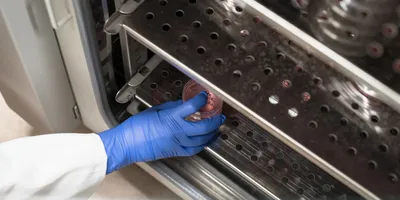Scientists started using some form of vacuum centuries ago. This technology has evolved extensively since Arabic engineer Al-Jazari invented the suction pump (a predecessor to the vacuum pump) in 1206. As a result, there are many options for scientists requiring a vacuum for their applications, and it’s a more complicated process to pick the best vacuum pump for a lab.
“One of the biggest challenges is selecting and using the correct vacuum pump for a given application,” says Dan McDougall, manager, laboratory products at KNF Neuberger. “If a pump is under-sized for the application, it will either deliver less than desired results or will simply take too much time; if the pump is over-sized, it will cost more and also prove problematic for the application.”
McDougall discussed two examples: First, rotary evaporation depends on a pump that provides optimal flow for the system volume and provides the depth of vacuum that is appropriate for the vapor pressure of the solvents being used. “An under-sized pump will be slow in evacuating the system and may not provide an end vacuum capable of pulling off the solvent,” he says. “An over-sized pump will be too fast, causing bumping and insufficient condensation/solvent recovery.”
Second, filtration applications also depend on the right-size pump. Here, “an under-sized pump will perform too slowly and not have enough depth of vacuum to adequately separate the liquid from the particulate,” McDougall says. “At the other extreme, an over-sized pump runs the risk of tearing the filter paper from the use of too much force.”
Futuristic features
Scientists can even consider some options that go beyond a typical vacuum pump. Instead of putting pumps everywhere vacuum is needed, for example, a lab can install a modular system. Here, a single vacuum pump serves more than one workstation in a lab, similar to a vacuum system in a woodworking shop. The modular approach can significantly reduce the energy that a lab uses for creating vacuums.
Other vacuum pump features are also changing. “In the near future, more and more lab vacuum pumps are going to be equipped with DC motors,” McDougall says. “Compared to the more common AC motor vacuum pumps, those with DC motors are robust, energy efficient, quieter, and provide speed control over the vacuum process.”
For any kind of vacuum pump, the device must meet the needs of the expected applications. “The best way to meet the challenge of correctly matching the pump to an application is to discuss your needs with a pump expert, or to use an online pump selection tool such as labpumps.com,” McDougall notes.
From Al-Jazari’s 13th century suction pump to the vacuum devices of tomorrow, scientists and engineers keep developing new ways to reduce the pressure in a space. For a lab running multiple, similar applications, a modular approach can be an energy-saving option. If a lab runs a variety of processes, it might need more than one vacuum pump. Plus, older pumps could be replaced to benefit from technological advances. Surprisingly, it takes a lot of thinking to create nothing.









